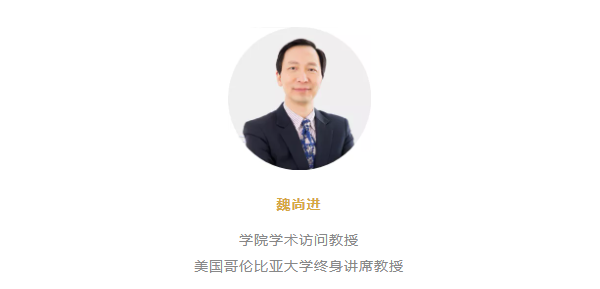
-
 86-21-63895588
86-21-63895588
-
 No.1, Lane 600, Nanchezhan Road, Huangpu District, Shanghai 200011
No.1, Lane 600, Nanchezhan Road, Huangpu District, Shanghai 200011
Release time:2021-09-28
During the period from March to September 2021, Professor Huasheng Gao, Donghui Shi, Shang-Jin Wei, Liang Jiang, Jarrad Harford, Shiyi Chen and Huafeng Chen at FISF have successively received admission or publication of 8 papers on A-level journals, including Journal of Financial Economics, Journal of International Economics, Review of Economics and Statistics, and Strategic Management Journal (in the order of the publication time). So far, the school has published a total of 74 papers on globally well-known journals, among which 50 were admitted by first-rate journals, constituting a huge contribution of wisdom to the financial innovation and development in China and all over the world.
The abstracts of the 8 papers admitted by A-level journals are as follows:

The paper entitled “Does Good Luck Make People Overconfident? Evidence from a Natural Experiment in the Stock Market” coauthored by Huasheng Gao, Donghui Shi and Bin Zhao was published in the Journal of Corporate Finance, a world-renowned publication. It studies the changes in the investment behaviors of personal investors in China after stagging successfully. Compared to those failing in stagging, these investors display overconfidence: they are doing business more frequently, and are more likely to buy gambling lottery-like stocks, causing a decrease in return on stock investment instead. This phenomenon is particularly evident for less experienced investors. Evidence in the paper shows that good luck can be blinding and may lead to overconfidence.

The paper entitled “Deadly Discrimination: Implications of ‘Missing Girls’ for Workplace Safety” coauthored by Zhibo Tan, Shang-Jin Wei and Xiaobo Zhang was accepted for publication by the globally renowned Journal of Development Economics. As a result of the traditional idea of preference of boys to girls, millions of girls in China, India, Vietnam, South Korea and many other countries failed to be born while they should have. This is called “lost girls” in the document. The paper focuses on the indirect but deadly consequence arising from such phenomenon. Covering such a wide territory, different regions in China may vary greatly in punishing the idea of preference of boys to girls and violation of the family planning policy, which results in different degree of gender imbalance. Depending on the difference of gender proportion among young people in China in various regions and time period, as well as four different databases, the paper explores the relationship between the degree of gender imbalance and local production safety, and discovers that in regions severely lacking females at the marriageable age, the incidence of parents of males at the marriageable age suffering from accidental injuries and death related to their workplace is remarkably higher. In conclusion, reducing gender discrimination can increase production safety.

The paper “Bootstrap Inference for Quantile Treatment Effects in Randomized Experiments with Matched Pairs” coauthored by Liang Jiang, Xiaobin Liu, Peter C.B. Phillips and Yichong Zhang was published on the world-leading journal Review of Economics and Statistics. The paper discusses the inference method for quantile treatment effects in randomized experiments with matched pairs. It finds that the traditional bootstrap inference method may give rise to the problem of conservative verification as it cannot depict negative correlation issues in the pairs, while distribution analysis requires to choose multiple adjusting parameters. The paper proposes two types of bootstrap inference methods, both of which can precisely approximate the limit distribution of quantile treatment effects and avoid parameter adjustments. The method weighted by the propensity score, in particular, can be applied to randomized experiments with matched pairs with unknown identifications.

The paper “Anticompetitive Effects of Horizontal Acquisitions: The Impact of Within-industry Product Similarity” coauthored by Maryam Fathollahi, Jarrad Harford and Sandy Klasa was recognized by the world-leading Journal of Financial Economics. It predicts that in concentrated industries with relatively high product similarity, horizontal acquisition can effectively raise the market competitiveness of existing enterprises. Based on a new method to measure product similarity in an industry, the paper discovers that in such industries, enterprises are more inclined to conduct horizontal acquisitions, which will bring more active announcement returns to the acquiring firms and competitors while paying higher premiums to the target companies. In addition, these transactions will cause damage to companies dependent on customers and suppliers. They will be more likely to be challenged by antitrust institutions. Overall, by emphasizing the significance of product similarity, the paper is an empirical result conducive to explaining the inconsistent conclusions of whether horizontal acquisitions can be used to reduce competition intensity.

The paper entitled “Endogenous Corporate Leverage Response to a Safer Macro Environment: The Case of Foreign Exchange Reserve Accumulation” coauthored by Hui Tong and Shang-Jin Wei was published on the globally first-rate Journal of International Economics. It points out that by taking measures like enhancing foreign exchange reserves, a country can strengthen its defensive capability to deal from the macroscopic level with sudden reversal of international capital flows or fluctuations in international interest rates, and lesson in principle the financial vulnerability of its enterprises and the whole economy. However, the effectiveness of such policies may be offset by more risk behaviors at the microscopic level conducted by domestic enterprises. According to data, the paper identifies a steady but previously unnoticed rule that the leverage ratio of enterprises often rises with the increase of national foreign exchange reserves. This rule is more vivid in uncertain and more sensitive industries. In terms of methodology, solving causality is a two-pronged instrumental variable strategy: on one hand, adopting the price fluctuation of global commodities and the proportion of commodities in exports to determine the instrumental variables of foreign exchange reserves, and on the other hand, focusing on the leverage behaviors of companies with neither the input nor the output dependent on commodities.

The paper entitled “The ‘Butterfly Effect’ in Strategic Human Capital: Mitigating the Endogeneity Concern About the Relationship Between Turnover and Performance” coauthored by Guoli Chen, Xin Deng, Huasheng Gao and Ithai Stern was published on the world-renowned Strategic Management Journal. It states that studies in the past did not solve endogeneity concern about the relationship between turnover and performance: it can be either the loss of human capital causing declined performance or the declined performance causing the loss of human capital. Taking Fukushima nuclear power leak as an exogenous shock, the paper analyzes how this event has affected US enterprises close to nuclear power plants in the US. The conclusion is: For fear of nuclear power arising from Fukushima nuclear power leak, there has been an evident tendency of voluntary employee resignation from enterprises close to nuclear power plants in the US (even though the local nuclear power facilities were not affected by Fukushima tsunami in Japan). This exogenous turnover boom leads to declined performance of these US enterprises.

Shiyi Chen, Michael T. Chng and Qingfu Liu coauthored the paper “The Implied Arbitrage Mechanism in Financial Markets”, which was published in the famous, Journal of Econometrics. The paper referred that no arbitrage condition is a basic concept in financial market research, but often the arbitrage mechanism implied in securities trading is rarely observed. For this, it analyzes the implied arbitrage mechanism in financial markets by constructing the generalized smooth transformation of vector error correction model (GST-VECM), proving the applicability of GST-VECM to market arbitrage in various situations on the basis of explaining the major concepts of GST function parameters. Unlike existing studies, GST-VECM can figure out the implied arbitrage section, evaluate the arbitrage intensity of upper and lower limits of asymmetry and introduce convergence risk in statistic arbitrage. Taking the example of the future-spot arbitrage before and after the launch of China’s CSI300 ETF, the paper uses GST-VECM to specifically reveal how changes in structural policies at the microscopic level influence the pricing relativity between stock index futures and spot market and further transform the future-spot arbitrage mechanism.

The paper entitled “Measuring Operating Leverage” coauthored by Huafeng Chen, Jason V.Chen, Feng Li and Pengfei Li was published by world-famous Review of Asset Pricing Studies. It studies a simple operational leverage metrics: the ratio of fixed cost (measured by adding depreciation and amortization to selling, general and administrative expenses) to capital market (or book) value. The paper finds that such method of measuring operational leverage can positively predict returns. It is not explained by common factors. On the other hand, it performs better than traditional operational leverage methods. Besides, the exploratory two-factor model with the factor of the operational leverage is at least as effective as Fama five-factor pricing model.
(The papers above are listed in the order of their publication time.)